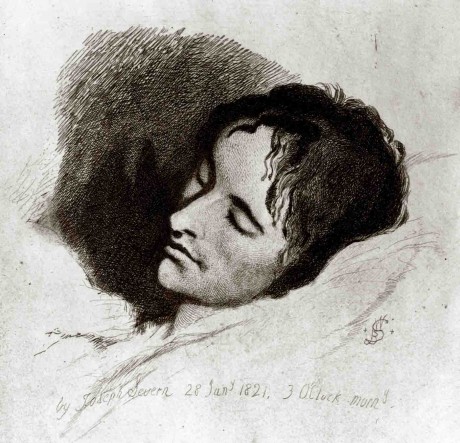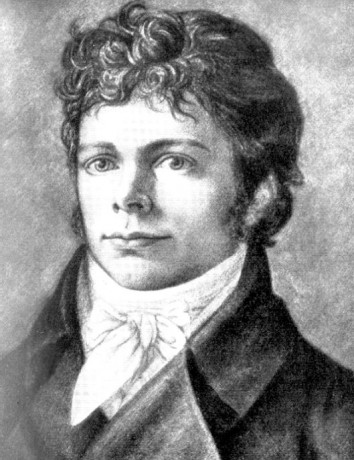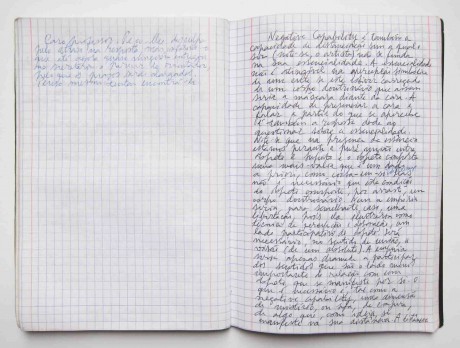NEGATIVE CAPABILITY
“(…) – I mean Negative Capability, that is when man is capable of being in uncertainties, Mysteries, doubts, without any irritable reaching after fact & reason.”,
John Keats, carta de 21 de Dezembro de 1817

Keats no leito de morte, 1821
Negative Capability é também a capacidade de distanciação sem a qual o ser não se funda na sua essencialidade. A essencialidade não é atingível na apercepção simbólica de um ente se este estiver carregado de um corpo doutrinário que assim seria a máscara diante da cara. A capacidade de presenciar o rosto e falar a partir do que se percebe é também a resposta dada ao questionar sobre a essencialidade. Note-se que na presença da essência estamos perante a pura união entre objecto e sujeito e o objecto comporta uma mais-valia que é um dado a priori, como coisa em si. Mas não é necessário que esta condição do objeto comporte, por arrasto, um corpo doutrinário. Nem a empiria seria, para semelhante caso, uma libertação, pois ela ilustraria, como técnica de percepção e observação, um lado participativo do objeto. Será necessário, no sentido da união, a visão (de um absoluto). A empiria seria apenas chamada a participar dos sentidos que são o lado menos importante da relação com um objecto que se manifesta por si. O que é necessário é, tal como a negative capability, uma dimensão de mistério, ou seja, de lonjura, de algo que, como ideia, se manifeste na sua distância.
A distância em relação ao objecto é o espaço tangível da ideia, que se manifesta e que tem lugar no tempo de produção da obra. Este tempo não é histórico e entra em conflito com o devir, ou seja, com a matéria. A história como matéria é o lado que nega a espiritualidade de um objecto. O objecto dotado de espiritualidade necessita de um campo não-empírico para a sua percepção, ligando-se com o inconveniente e demonstrando frontalmente a sua propriedade (a da manifestação ou a da revelação). Revelar é dar a ver no imediato a sua propriedade máxima, ou seja, total, a qual não é comunicada pelos sentidos mas dada na transmissão da ideia, num mecanismo semelhante à metempsicose, à transmigração das almas. Assim a ideia participa (e é o seu lugar) do carácter místico do objecto.
Ora, observamos que todo o misticismo parte aqui do objecto e não do sujeito. De facto, um místico (sujeito) não é senão um reflexo do mundo, portanto, da essência espiritual dos objectos. Mas só a história é matéria tangível, ou seja, proximidade. Um objecto distante (dado por isso na sua negatividade) revela-se por si só, como ideia, e no íntimo revela a sua aura. Será um símbolo despido dos seus códigos, isolado. Se a história é discurso, o símbolo (ou seja, o objecto artístico) revela-se na sua ideia, na desarticulação com o discurso, na sua transversalidade e distância. Quanto mais distante for, maior será o peso da sua anunciação. O objecto dotado de aura, como uma ideia, paira no limbo e desliga-se da empiria para adquirir as propriedades do mistério: é essa a sua grandeza que é o que o torna indecifrável e incomparável.
A empiria liga-se com o presente tal como as diversas epistemologias. A semiótica não é um discurso livre pois encarrega-se da enunciação dos seus códigos característicos. Os códigos não são tanto os da experiência, mas mais os da demonstração da experiência. Com a negative capability de J. Keats, a experiência liga-se ao seu contrário, sem possibilidade de demonstração. A brevidade da sua explicação demonstra antes a sua própria profundidade. É no seio do ser-em-si que a experiência nasce e que assim se transforma constantemente, não deixando que os códigos mais diversos a captem. Para a aura, os códigos são sempre limitadores.
O sujeito empírico não se apercebe diretamente da ideia pois primeiro tem de interpretar a realidade. Ora a ideia nada tem que ver com a realidade. Diferente do determinismo, não nasce num momento para depois desaparecer. É eterna. O contacto da ideia com a arte é o próprio eternizar do objeto. Este contacto é, para além do sublime, a prova de uma superioridade: a da própria eternidade das ideias. Na sua relação com o mistério, as ideias desligam-se de toda a aparência material, pois a aparência sugere os códigos e, a partir deles, a interpretação. A ideia não existe para ser interpretada. Se não nasce (pois é eterna), também não existe historicamente (ou seja materialmente). A obra de arte confunde-se com a eternidade na medida em que alberga a ideia que, tal como não nasce, também não morre. O movimento das ideias é o sentido romântico do organicismo: está presente nas árvores, nos ramos e nas folhas e sujeita o ser ao descanso à sua sombra. De facto, na obra de arte ideal, o sujeito submete-se à sua sombra, à sua tonalidade. Mas não pode perceber a árvore na sua totalidade.

O filósofo Schelling
Só a arte representa o absoluto pois une sujeito e objeto (Schelling). Esta relação não é posterior à sua produção, mas anterior: o sujeito é, aqui, o produtor. A própria crítica encarrega-se de estabelecer um erro na sua procura de verdade, pois vê na arte apenas a sua posterioridade e nunca a sua anterioridade. Assim, a própria crítica, como empiria, nunca poderia estar do lado da produtividade. Secularmente, a crítica estabelece-se do lado da recepção e apreciação, apercebendo-se das ideias parcialmente, nunca se realizando completamente. Mas nisto reside, precisamente, a sua mais-valia. Pois o lado sombrio da crítica é valer-se do efeito e nunca compreender o objecto na sua totalidade, ou seja, na manifestação da sua ideia. O seu lado sombrio é o reflexo da sombra que o próprio objeto emana, o seu mistério, a sua irregularidade, a sua singularidade.
Mas para o objecto que comporta eternidade (como propriedade infinita, inesgotável), a sua sombra é apenas a sua posteridade que se confunde, erroneamente, com a sua recepção. No seu ocaso, o objecto deve esconder a sua antecedência, que é lado luminoso de onde emite os seus raios de luz. Tal como na Alegoria da Caverna de Platão, o objeto sobe até à luz do Sol e isto torna-se uma propriedade recorrente de compreensão desse objeto, compreensão nunca compreendida, nunca total, pois não é de um momento que ele vive, mas da sua eternidade. A teoria platónica das ideias serve de ilustração a toda a construção. Mas o que a crítica (mesmo a mais bem fundamentada) não consegue compreender é que o objecto artístico reflecte a luz das ideias, tornando-se inesgotável, e que nisso reside a sua negatividade, a sua negative capability, a da não coincidência com a sua sombra.
J.V.
“Negative Capability”, manuscrito, 2008
««««»»»»
Negative Capability is also the capacity for distance without which the being is not grounded in its essence. Essence is not reached in the symbolic apperception of an entity if this one is filled with a doctrinal body that would be the mask before the face. The capacity to witness the face and speak from what we perceive is also the given answer to the questioning about the essence. It should be noted that in the presence of the essence we are in front of the pure union between object and subject and that the object holds an added-value which is an a priori evidence, as a thing-in-itself. However, it is not necessary that this condition of the object bring with it a doctrinaire body. Nor would empiricism be, in such a case, an alleviation, because it would present (as a technique of perception and observation) a participative side of the object. It will be necessary, in a unifying sense, the vision (of an absolute). Empiricism would be called only to participate in the senses, which are a less important side of the relation with an object that manifests itself. What is necessary is, like the negative capability, a dimension of mystery or, in other words, of remoteness, of something that, as an idea, is manifested in its distance.
The distance towards the object is the tangible space of the idea, which is manifesting and has a place in the time of the production of the work. This time is not historical and gets into conflict with the becoming, that is, with matter. History as matter is the part which negates the spirituality of an object. The object endowed with spirituality needs a non-empirical field for its perception, connecting with the inconvenient and bluntly showing its property (that of manifestation or revelation). To reveal is to show its maximal property in the immediate, that is, complete, the one that is not communicated by the senses but given in the transmission of the idea in a mechanism similar to metempsychosis, the transmigration of souls. In this way is the idea participating (such is its place) in the mystical character of the object.
Now, here we observe that the full mysticism starts from the object and not from the subject. In fact a mystic (a subject) is nothing but a mirroring of the world, therefore, of the spiritual essence of the objects. But only history is tangible matter, namely, proximity. A distant object (therefore given in its negativity) reveals itself in itself, as idea, and thus intimately revealing its aura. This will be a symbol stripped from its codes, isolated. If history is discourse, then the symbol (the artistic object) reveals itself in its idea, by disarticulating speech, by being transversal and distant. The more distant it is, the heavier the weight of its annunciation. The object endowed with aura, as an idea, hoovers in a limbo and disconnects from empiricism in order to acquire the properties of mystery: that is its greatness and that is which makes it indecipherable and incomparable.
Empiricism connects with the present just like the various epistemologies. Semiotics is not a free speech because it undertakes the enunciation of its characteristic codes. These codes are not so much those of experience as the ones of the demonstration of the experience. With J. Keats’ Negative Capability the experience connects with its opposite, but without the possibility of demonstration. The briefness of its explication shows above all its own profundity. It is amidst the being-in-itself that experience is born, constantly transforming and not letting the most diverse codes capture it. For the aura, the codes are always limiting.
The empirical subject does not directly perceive the idea because first he has to interpret reality. Now, the idea has nothing to do with reality. Apart from Determinism, it is not born in a moment so as to vanish afterwards. It is eternal. The contact of the idea with art is its own eternalizing of the object. This contact, in addition to the sublime, is the proof of something superior: the eternity of ideas. In its relation with mystery, the ideas are disconnected from every material appearance because appearance suggests the codes and, out of these, their interpretation. The idea does not exist in order to be interpreted. If it is not born (because it is eternal), it also does not exist historically (materially). The work of art combines with eternity in the sense that it shelters the idea that it is unborn and so it does not die. The movement of ideas is the romantic sense of Organicism: it is present in the trees, in the branches and in the leafs, and forces the subject to rest under its shadow. In fact, in the ideal work of art, the subject surrenders to its shadow, to its tone. But he cannot perceive the full tree.
Only the art represents the absolute because it unites the subject and the object (Schelling). This relation is not posterior to its production but previous: here, the subject is the producer. Criticism itself assigns the establishment of an error in its search for the truth, because it sees in art only its posterity and never its precedence. Therefore, criticism takes the sides of reception and appreciation, partially perceiving the ideas, never being completely achieved. This is, precisely, its added-value, because the darker side of criticism is to get hold of the effect and never comprehending the object in the full or, in other words, the manifestation of its idea. Its darker side is the reflex of the shadow that the object itself emanates, its mystery, its irregularity, its singularity.
For the object that carries eternity (as infinite, inexhaustible property), its shadow is only its posterity that confuses, mistakenly, with its reception. At its sunset, the object must hide its precedence, which is a luminous side from which its rays of light are breaking. Just as in Plato’s Allegory of the Cave, the object climbs for the sunlight and this a recurrent property of the comprehension of that object, comprehension that is never really fulfilled, never complete, because it is not just from a moment that the object lives but from its eternity. The Platonic Theory of Ideas serves as illustration of the whole construction, but what even the most well-founded criticism cannot comprehend is that the artistic object reflects the light of the ideas, becoming inexhaustible and that is its negativity, its Negative Capability, the one of uncoincidence with its shadow.
J.V.
